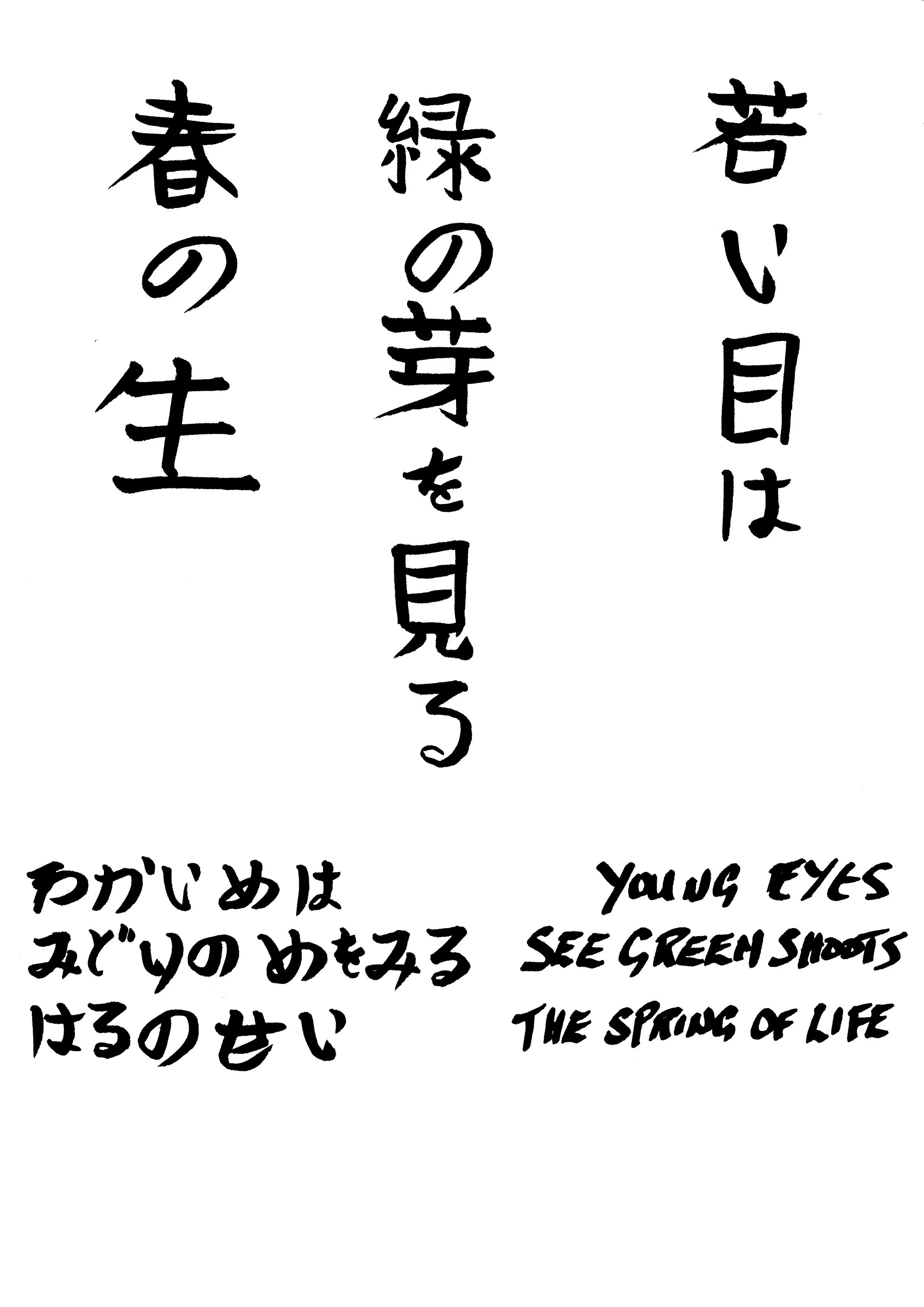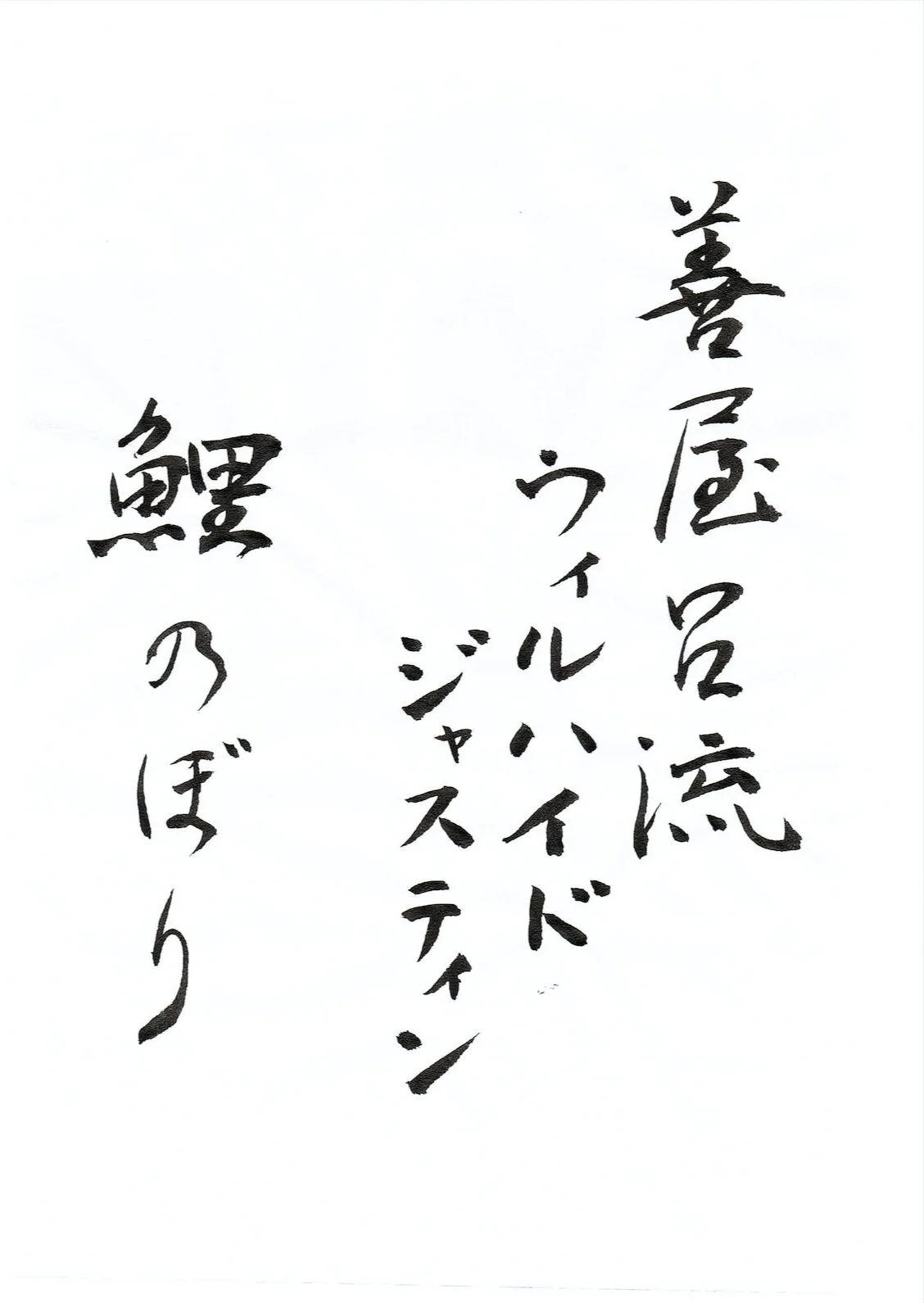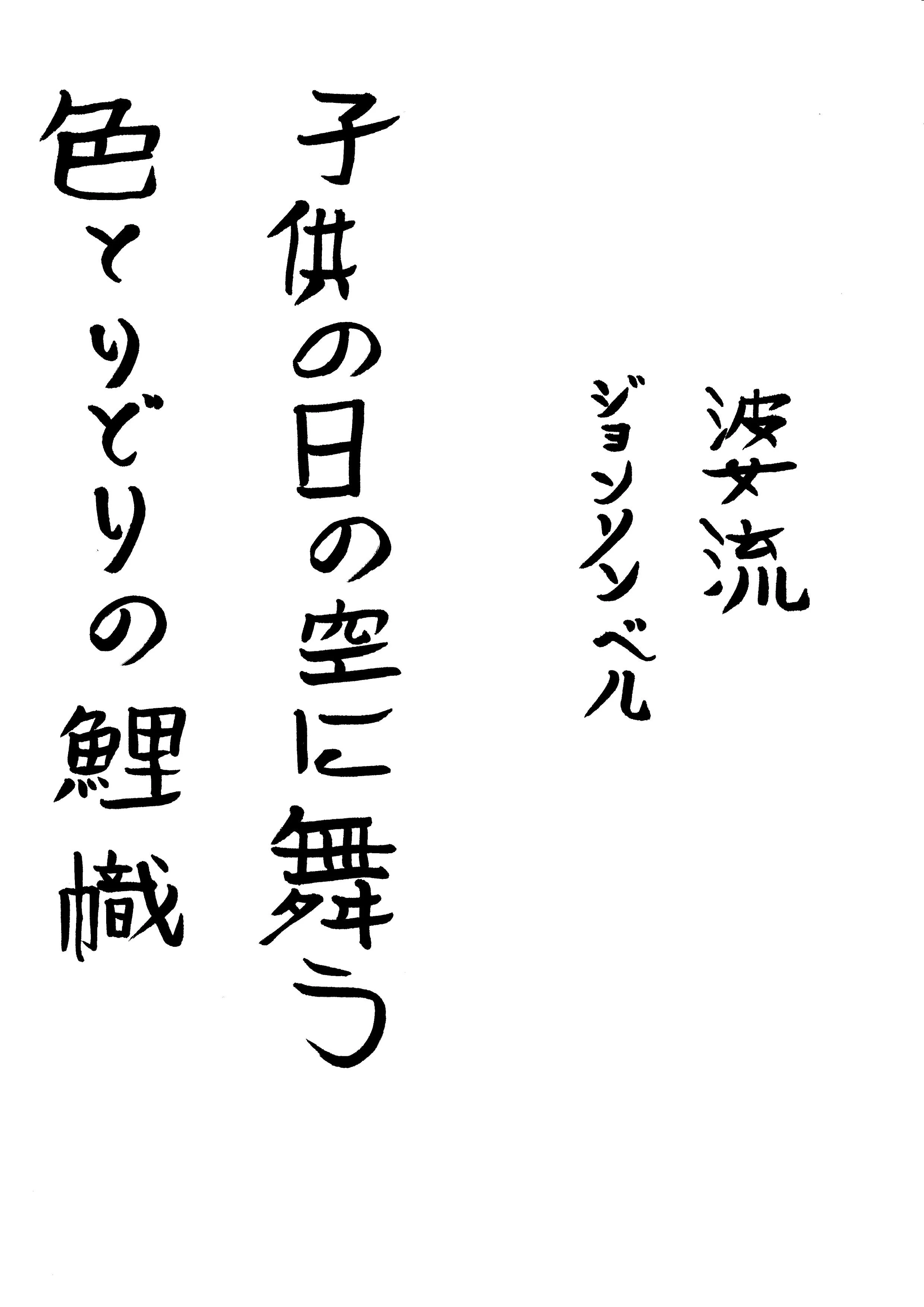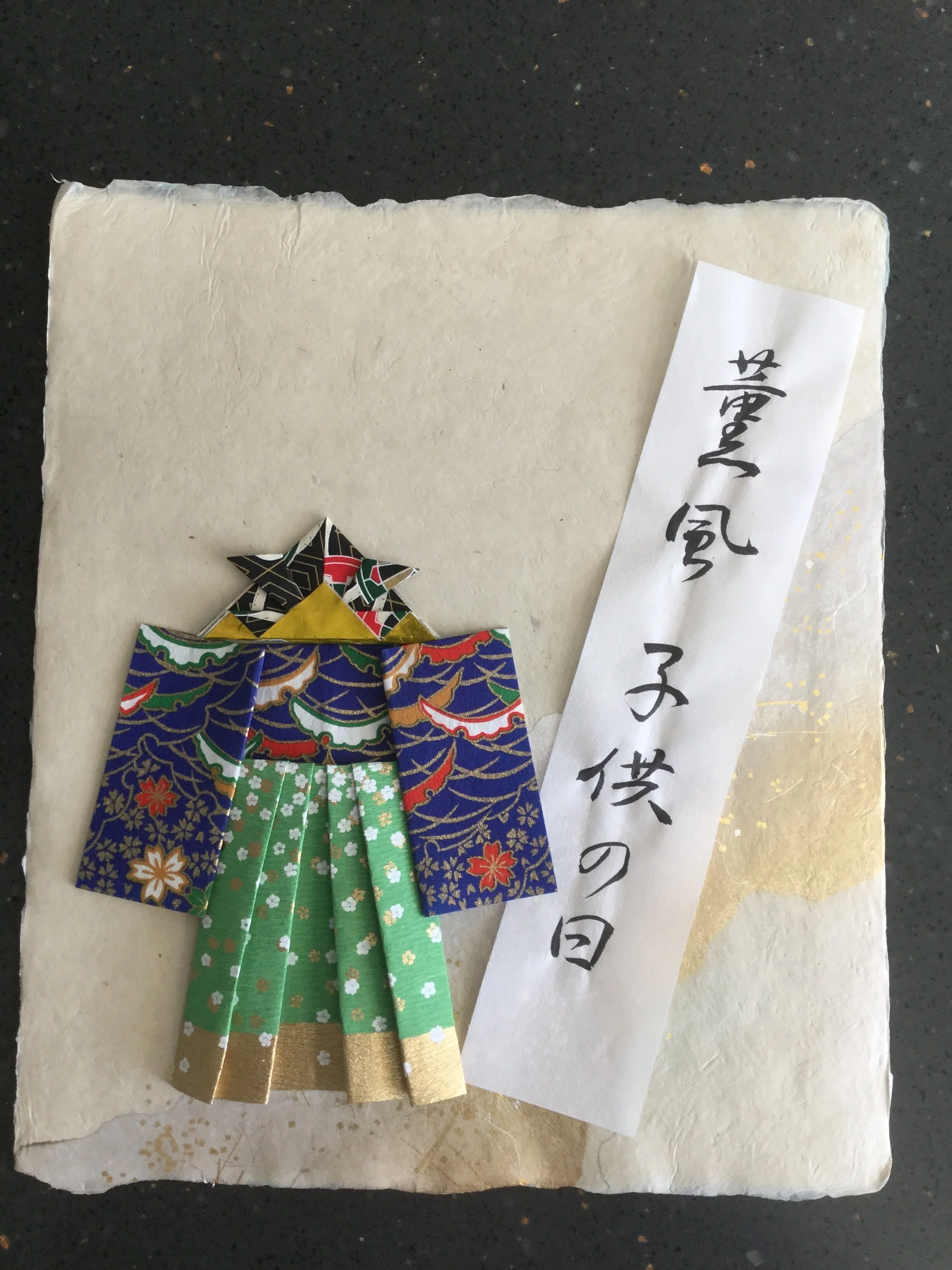子供の日(Kodomo no hi) Children’s Day
On 5th May in Japan is held Tango no sekku or the Iris Festival. It was originally for boys. But in 1948 it was renamed Kodomo no hi or Children’s Day and was granted national holiday status. Carp shaped kites are displayed on this day. In Chinese classical literature a carp swims upstream becoming a dragon and flying to Heaven. This implies success in life. Samurai helmets or armour are also displayed on this day as a symbol of strength and vitality. Children take baths with Japanese iris leaves called Shōbu-yu. Because of their distinctive aroma, these scented baths are also thought to have power to ward off evil spirits. People also eat Kashiwa-mochi (rice cakes wrapped in an oak leaf) or Chimaki (rice or arrowroot cakes wrapped in bamboo leaves).
This exhibition is a collaboration between Morley Advanced Japanese woodcut printmaking students and Japanese language students (Stage 4). Carol Wilhide Justin is the tutor for Japanese woodcut who knew Hisano Luttman from studying in her Japanese language classes. Together they decided to collaborate on an exhibition related to the Japanese festival of Children’s Day on May 5th. Carol’s students chose aspects of the Children’s Day that inspired them for their prints: koinobori- the kites, kokeshi dolls, hana shobu iris leaf bath, carp and plum blossoms. Hisano’s students wrote the titles of the prints and artists names in Japanese characters and also made haiku and origami koinobori.
The Japanese language is written in three different alphabets Hiragana, Katakana and Kanji. Usually foreign names should be written in Katakana but here the students tried differently. The first names of the artists are written in Kanji (Kanji here were chosen from the pronunciation) and the surnames in Katakana. They read from right to left- with the artist’s name on the right and the title of the print on the left.
For the Japanese Woodcut prints shina plywood was used for the woodblock, it has a fine grain and is easy to cut unlike the traditional cherry wood where you would use chisels and mallets. For printing instead of oily inks, watercolour pigments and nori -a rice starch were used. The watercolour is brushed onto the dampened woodblock using special Japanese brushes. Dampened Washi paper- that is Japanese paper developed specifically to deal with the technique is laid onto the block using the integral unique Kento registration system- notches cut into the block where the paper corners fit. No presses were used each print is handmade using a bamboo baren, transferring the pigment from the block to the paper. Inge’s print shows the use of karazurie or embossing, Margaret and Elizabeth experimented with urazurie or printing from the back of the print. Other techniques used include bokashi or graduated colour as seen in Veronica’s print.
Calligraphy: Hisano Luttman (reading r to l) Carol Wilhide Justin Koinobori Koi Kites
Koinobori
koinobori
swimming in the sky
below cherry blossoms fall
Artist: Carol Wilhide Justin
Japanese Woodcut on Pansion paper, coloured threads, 4 x 30cm x 7cm
Calligraphy: "Ichi byou ni go senchi" by Jordan Easy.
Five Centimetres per second
Artist: Inge Eicaite
Japanese Woodcut with emboss on Asashi paper, 24 x 13 cm
Plum blossom symbolises perseverance and hope, as well as, beauty thriving in adverse circumstances. As the plum tree blossoms between two seasons, it is also seen as a symbol of spring - bringing warmth, transition and the promise of fruitfulness.
Japanese tradition holds that the ume functions as a protective charm against evil, so the ume is traditionally planted in the northeast of the garden, the direction from which evil is believed to come.
Inge
Calligraphy: Elisabet Pujol (reading r to l) Julie George Hontou ni taisetsuna koto - What really matters
What really matters
Artist: Julie George
Japanese Woodcut on Hosho paper, 2x 17cm x 17cm
Thinking about the importance of culture and traditions to make one feel a sense of belonging and well-being.
Calligraphy: Corrina Power (reading r to l) Elizabeth Meyers Gofu Talisman
Talisman
Artist: Elizabeth Meyers
Japanese woodcut with printing on reverse on Kitakata Select paper, 30 x 21 cm
While researching this festival I was drawn to some of the significant plants used as symbols throughout the Children’s Day-Kodomo No Hi and its earlier emanation of Boy’s Day- Tango no Sekku.
Iris leaves and roots thought to promote good health and ward off evil spirits and used to make an aromatic bath water. Oak leaves used to wrap the little Kashiwa Mochi sweets, assure continuing good health. These seemed to be remnants of much older spring celebrations similar to many cultures celebrating continuity of nature, birth and the recognition of the incredible life force and vigour contained within emerging leaves, buds and ultimately animal/ human birth.
The Japanese Oak is the Quercus Dentata sometimes called the Japanese Empereor Oak or the Sweet oak. It’s indented salted leaves wrapping the Kashiwa mocha as part of the Childrens Day food ritual. I loved the fact that the leaves are displayed with veins exposed or hidden to indicate what the filling is inside the mochi.
I had a picture of the Japanese oak and admired its complex outline but somehow was not happy working from this second hand image. As I was unable to travel to Osterley park in West London ((where there is an identified Japanese Oak )to find a specimen leaf I had to be content with an common English oak leaf ;Quercus robur, from a tree near my allotment in South London. Actually I had more personal connection with this leaf and thought the simpler shape more instantly recognisable as an oak and more symbolic rather than botanically accurate.
Looking at the type of Iris used in the childrens day festival it appeared that in the past people used the purple Iris tectorum or wall/roof Iris but in more modern times it is’ hana shobu’ or Japanese water Iris which has bigger taller leaves. Googling iris tectorum I came across research on the morphology of iris buds by Botanists Jin Yan Guo and Carol Anne Wison and I was intrigued by their microscope images. They reminded me of ultra sound scans of babies in the womb and I seemed to see little faces within .
I have decided to use these round iris bud medallions within the shape of the oak leaf whose shape is reminiscent of a body, an island and a shield.
I wanted to try out the method of printing known as Urazurie or printing from the back and thought that it might be a good way of depicting the slightly transparent microscope images and also suggest images and ideas that are perhaps behind or underneath the surface imagery and rituals of Children’s Day
Calligraphy: Anna Espuig (reading r to l) Lois Hadley Ni hiki no koi Two Carp
Two Carp
Artist: Lois Hadley
Japanese Woodcut on Shoji paper, 19 x 27 cm
The koi fish originated in China where there is a legend of one leaping over a waterfall called Ryumon and transforming into a dragon (representing power/success). However, the Japanese embraced its Buddhist symbolism of courage and it became associated with young boys and the hope they would grow into a dragon (great man). The koi is closely linked to Japanese national identity- if a koi has a red circle on its head this can represent the Japanese national flag. The koi is often shown swimming upstream – representing strength and determination in the face of adversity.
In Japanese culture, colours have traditional connections. In connection with Children’s Day: black represents a father, red is the mother, pink is a girl/daughter and blue and white are symbols of a boy/son. Blue also represents peace, tranquillity and calm.
Calligraphy Corrina Power (reading r to l) Margaret Cooter Kodomo tachi no yuurei - Ghost Children
Ghost Children
Artist: Margaret Cooter
Japanese woodcut on Chinese calligraphy paper “Grass Paper”, 26 x 18.5 cm
A family can include “ghost children” -stillbirths, miscarriages, abortions,, even those that are desperately desired but not conceived. This “happy family” is wearing clothing with traditional auspicious patterns.
Calligraphy: Steve Gibbons (reading r to l) Val Johnson-Bell Kodomo no hi no sora ni mau iro toridori no koinobori Colourful Koi Kites fill the skies on Children’s Day
Colourful Koi Kites fill the skies on Children’s Day
Artist: Val Johnson-Bell
Japanese woodcut on Hosho paper, 23 x 19 cm
What a lovely thing for a country to do – have a Children’s Day. In Japan this day, 5 May, is traditionally a special day for children and there are many different ways of celebrating it. I chose to make a woodcut on the theme of Koi kites or, in Japanese, Koinobori. The koi carp represents a strong and spirited fish that can swim and jump up waterfalls and these qualities are what parents hope for their children. The brightly coloured kites are flown everywhere – town and country – from private houses and public buildings. It is a very colourful and uplifting sight. I have tried to capture the happy mood with colour and movement.
Calligraphy: Anna Espuig (reading r to l) Veronica Howard Fuyuu Floating
Floating
Artist : Veronica Howard
Japanese woodcut on Hosho paper, 20 x 14.5 cm
The leaves and roots of the iris are put into bath water
Origami
Hisano also delivers Origami and greeting card workshops related to the Japanese seasonal festivals in the class.
If anything in this exhibition has piqued your creative fancy, why not try a course? Follow the links below to sign up for Japanese Woodcuts, Japanese Calligraphy and Japanese Language courses at Morley College.
























